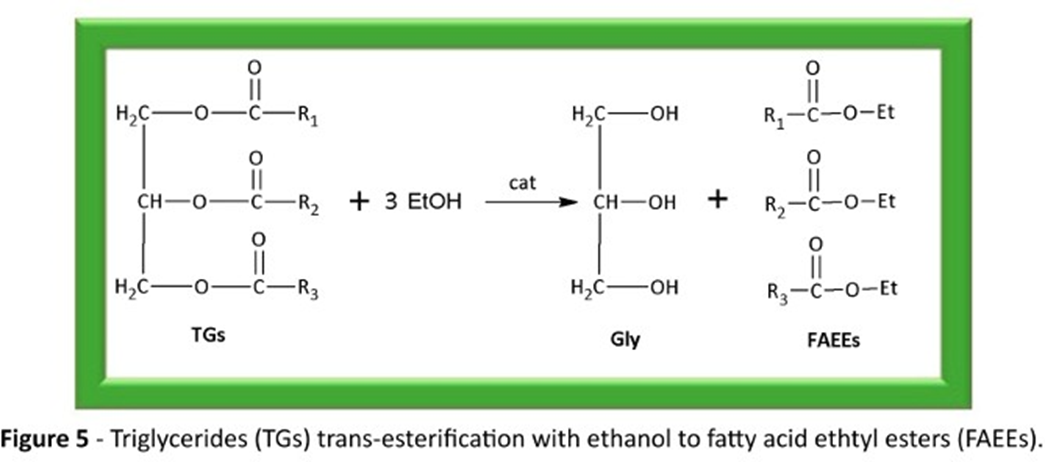Task3.1 Grease (from grease separation) esterification and purification
GRFSS will be directly converted into FAEEs using AlCl3•6H2O catalyst, with the aim of promoting an intensification of processes, by combining the reactivity (direct esterification) to the prompt separation of products from water and catalysts (Figure 4).

This profitable approach was already verified using methanol, whereas, according to our knowledge, the direct esterification of long fatty acids coming from sewage scum with ethanol was never studied. The reactive conditions will be optimized to achieve a crude product composed by ethyl esters for 90% at least. Afterward, the best purification route will be designed and performed including distillation under vacuum and dry washing using conventional (Magnesol) and new solid materials (based on SiO2, silicates and other minerals).
Task 3.2 Yeast lipids trans-esterification
The SCOs extracted in Task2.2.3 will be directly used as substrate for trans-esterification to FAEEs using (bio)ethanol as reagent and solvent (Figure 5)

Different acid and alkaline homogeneous catalysts will be tested such as BCl3, NaOH and KOH. To optimize the process, some important variables such as temperature, reaction time, molar ratio of ethanol to oil and catalyst amount will be investigated. The FAEEs profile will be determined by GC-FID and GC-MS analysis to study the effect of the oil recovery approach and oil trans-esterification method on the FAEEs chemical compositions and psycho-chemical properties in the perspective of the motor tests (WP4).
Task3.3 Hexanoic acid catalytic reductive esterification:
HexHex represents a strategic blendstock for diesel/biodiesel fuels and its production by catalytic reductive esterification of raw HexAc as obtained from Task2.1 will be optimized in the presence of heterogeneous catalysts (Figure 6).

For the successive application of the reaction mixture as diesel blendstock the eventual co-production of hexanol as byproduct does not represents a drawback, while the hydrogenolysis and decarboxylation reactions must be avoided. Preliminary studies will be performed adopting batch 250 mL Parr autoclaves on solvent-free commercial HexAc as reference. Then the most promising systems will be employed on crude acid deriving from anaerobic fermentation, after its complete analytical characterization. In order to improve the process yield novel bifunctional catalytic systems will be tested, characterized by the presence of a non-precious metal (as Cu, Ni and Co) and of an acid support (as Nb2O5 or Al2O3). The acid support is in fact able to strongly interact with the carbonyl group of the acid increasing its electrophilicity and therefore its reactivity. The role of the main reaction parameters (metal loading, hydrogen pressure, temperature, duration) on the yield of the reductive esterification process will be studied, as well as eventual deactivation effects, in particular when the real fermented HexAc-rich liquor will be adopted. HRTEM, XRD, SEM-EDX, XPS, ICP, N2 physisorption and FT-IR with probe molecules will be used for catalysts characterization, also adopting NH3 TPD to better quantify type and amount of acid sites on the catalyst surface. The characterization of fresh and spent catalysts as well as of the reaction by-products will help to better explain the catalytic reaction mechanism and deactivation phenomena of this scarcely studied reaction, in particular in the presence of cost-effective non-precious metal catalysts. The optimized systems will be tested in larger scale experiments adopting 1 L Hastelloy C autoclave.
WP3: Ester productions
GREENCAT
Green Catalysis beyond Petroleum Age
● ● ●
Department of Chemistry and Industrial Chemistry
Via Giuseppe Moruzzi, 13
56124 - Pisa, Italy
RASPOLLI RESEARCH GROUP
greencat.dcci.unipi.it
● ● ●
Powered by
WMkk-Dcci-Unipi
Privacy Policy




